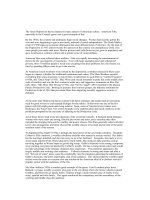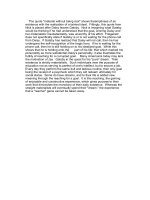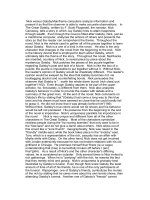natural wonders the great barrier reef
Bạn đang xem bản rút gọn của tài liệu. Xem và tải ngay bản đầy đủ của tài liệu tại đây (8 MB, 29 trang )
Contents
The Wonder Down Under 4
Where in the
World?
6
A Trip Back in Time 8
The Coral Reef Ecosystem 10
Life in the Reef 12
Early Explorers 14
The Big Picture 16
People ofthe Reef 18
Stories from the Reef 20
Natural Attractions 22
Key
Issues:
Protecting the Reef 24
Time Line 26
What Have
You
Learned? 28
Find Out for Yourself 30
Glossary/Index 32
^A
"«^^
Natural Wonders
The Wonder Down Under
he spectacular Great Barrier Reef is
the
largest coral reef in
the
world.
It
is
located
off
the coast
of
Australia,
one of
the most southerly
continents
on
Earth. Austraha
is so far
south ofthe equator that people
call
it
"down under."
The Great Barrier Reef is
not
only beautiful,
it is
also
an
important
ecosystem. Scientists study the reef to learn
how its
many animals live
and interact with their environment. Fishers rely
on the
reef to provide
fish for them
to
catch
in
nearby waters. Tourists visit
the
reef to scuba
dive
and
learn about nature.
The wonders
of
the reef lie very close
to the
water's surface.
Thé GreatBarrier Reef
Great Barrier Reef Facts
• The Great Barrier Reef stretches about
1,250 miles (2,012 kilometers) along
Australia's northeast coast.
• The Great Barrier Reef is the largest
structure in the world built by
living organisms.
• There are more than 10,000 different
species of animals living in the Great
Barrier Reef. Some have never been
named by scientists.
• The Great Barrier Reef is considered
one of the Seven Wonders of the
Natural World. Uluru,
a
huge rock
formation,
is another Australian site
on the list.
• In 1975, the Australian government
established the Great Barrier Reef
Marine Park to protect the coral reef
and its surrounding waters.The huge
park covers about 134,000 square
miles {347,058 sq km).
Great Barrier Reef Locator
8 Natural Wonders
A Trip Back in Time
he sea floor on which the Great Barrier Reef sits was formed about
500,000 years ago. Today's
reef,
however, is very different in size and
shape. Coral lives on top of many layers of dead coral from centuries ago.
Coral polyps start the process of reef building. These tiny creatures attach
themselves to coral rock or other hard surfaces underwater. Polyps become
coral as they grow hard skeletons outside their bodies. When certain kinds of
coral die, their skeleton shell remains. A reef consists of many of these dead,
rocky corals connected to each other. As new polyps grow on dead coral, the
life cycle starts over.
Coral polyps are living animals that stay in one place for their entire lives.
The Great Barrier Reef 9
of Reefs
Not all coral reefs grow in the same way. These are the three main
kinds of reefs. The orange areas represent coral
reef.
Side Viel
»verhead Viei
Type
Fringe reefs grow
in very shallow
water surrounding
land,
such as coasts
or islands.Theseare
the youngest types
of reefs.
Barrier reefs grow
in deeper water a
bit farther offshore.
They form a
wall,
or
barrier, between the
sea and the shore. A
lagoon sits between
the reef and shore.
Atolls are ringed
reefs that form
away from shore.
Some atolls grow
around the rim of
a sunken volcano.
10 Natural Wonders
The Coral
Reef
Ecosystem
Q
iving communities
in
nature
are
called ecosystems. Animals, plants,
and
the surrounding environment
all
contribute
to
making
an
ecosystem
work. Members
of
ecosystems
are
divided into groups called producers,
consumers,
and
decomposers. Each
of
these groups depends
on the
others
for survival.
In
the
Great Barrier
Reef,
producers
are
creatures such
as
algae, that
are
eaten
by
consumers. Coral polyps
are
consumers, feeding
off
the algae
that grow nearby. Thousands
of
types
of
fish
are
also coral reef consumers.
Decomposers, such as bacteria,
are
creatures that clean
the reef.
They
eat
the waste materials that other animals
and
plants leave behind.
a
The sea
cucumber
is not a
vegetable.
It
is
an
animal
and a
decomposer.
The
sea
cucumber crawls along
the
reef floor, eating waste material.
The Great Barrier Reef 11
The crown-of-thorns starfish is a dangerous member of the Great
Barrier Reef community. Since 1965, scientists have observed
periods when the crown-of-thorns population suddenly increased
in the
reef.
This type of starfish is a predator of coral. It feeds
directly on live coral
polyps. So, when the
crown-of-thorns
population increases,
it kills off far too
much coral and
threatens the entire
reef ecosystem.
9 It is difficult for
humans to remove
the crown-of-thorns
starfish from the
reef.
The dangerous
creature is covered
with poisonous spines.
12 Natural Wonders
Life in the Reef
ome of the most unique and beautiful creatures in the world live in
the Great Barrier Reef Glown, parrot, mandarin, and thousands
of other types of fish dart through the coral looking for food and shelter.
Larger animals, such as sharks and whales, live nearby. Crabs and sea turtles
live in the reef
waters,
but they sometimes leave the water and crawl around
on the beaches.
Many Great Barrier Reef beaches are home to hundreds of bird species,
including sandpipers, herons, and terns. These birds are also part of the
coral reef ecosystem, as they eat fish from the water. Many birds are just
visitors to the area. They migrate to Australia every winter from colder
countries in the north.
a The blue-ringed octopus
is
one of the reef's deadliest creatures. If bitten by
this
octopus,
an
adult human could die after only a few minutes.
The Great Barrier Reef 13
Coral Characte
More than 350 different species
of
coral live
in the
Great Barrier
Reef.
They take
on
many different shapes
and
colors. Only stony
corals grow skeletons outside their bodies
and
become reefs when
they die. Other corals, such
as
gorgonian coral, grow spines inside
their bodies. They
do not
turn into coral reefs.
The color
in
coral comes from
the
algae they eat. Only living
corals have color. Dead coral turns white. Coral "bleaching"
is
a term scientists use when large amounts
of
coral
die and
turn
white. Bleaching
is
usually caused
by a
drastic change
in the
reef environment.
In
1998,
sea
temperatures
around
the
world
increased suddenly,
'^^^
coral bleaching
destroyed large parts
of
reefs
in
Australia
and
other parts ofthe world.
a
A
certain species
of stony coral
is
called "brain coral."
14 Natural Wonders
Early Explorers
Ö
he first people to discover the Great Barrier Reef were the Aboriginal
Australians, who arrived in Australia about 50,000 years ago.
Aboriginal groups lived mostly on the coast of Australia and islands
of the
reef.
Explorers from Asia and Europe visited Australia's shores between the 1300s
and 1700s. These visitors did not settle in Australia because the land was
hard to farm and was far away from their home countries. When English
explorer James Cook
sailed to Australia in
1770,
he claimed the
land for England.
s When Captain
James Cook arrived
in Australia, he
named it New South
Wales.
It reminded
him of a part of Great
Britain called Wales.
The Great Barrier Reef 15
Biography
Matthew Flinders (1774-1814)
In 1802, the well-known British sea explorer Matthew Flinders
set off from England on a very important journey. Flinders was
the first person to sail around the entire Australian continent
and carefully map its shores. The Great Barrier Reef posed big
problems to ship captains. The sharp, rocky reefs could rip the
bottom out of
a
wooden ship. After several attempts. Flinders
succeeded in finding a safe passage through the
reef.
He spent
2 years exploring Australia. Today, this path is called
Flinders Passage.
In 1814, Flinders's journals about this
«.^=^^«>
journey were published as a book
titled A Voyage to
Terra
Australis.
Coincidentally, Flinders died at
the age of
40
on the very day his
book was published.
Born
: 1774
, England
occupation: Explorer, navigator
Died; 1814
The Big
Picture
Goral reefs exist in many
places around the world.
They need shallow, warm
water to support their
complex ecosystem. This
map shows some of the
major coral reefs and the
bodies of water that are
their homes.
I
TLA
N
ARCTIC
OCEAN
ASIA
EUROPE
AFRICA
Bay
of
Bengal
fNDlAN
OCEA
N
AR(
ocn
AUSTRALIA
IC
Í.V
P.ACÍFIC
OCEAN
P.4
CIFIC
OCEAN
NORTH
AMERICA
Cari/
SOUTH
AMERICA
Reef Name or Location
I.Florida
Keys
2.
Mexico
3.
Australia
4.
Philippine Islands
5.
Indian Ocean Coral Reef
6. Red Sea Riviera Reefs
Body of Water
Atlantic Ocean
Caribbean Sea
Pacific Ocean
Pacific Ocean
Indian Ocean
Red Sea
18 Natural Wonders
People of the Reef
a
boriginal Australians
and
Torres Strait Islanders lived
in
Australia
for thousands
of
years
before British explorers arrived. Aboriginal
Australians lived
in
areas near
the
Great Barrier
Reef, and
Torres Strait
Islanders lived
on
northern islands between Australia
and
Papua
New
Guinea. When Europeans began building colonies
in
Australia, many
of
these
indigenous peoples were treated poorly, sometimes violently. As newcomers
built more cities
and
towns, indigenous peoples were forced
out of
places
where they
had
lived
for
generations. Eventually, Aboriginal Australians were
forced
to
live
in
Australia's hot, dry, inland region called
the
Outback.
Today, indigenous Australian people have reclaimed some
of
their homelands.
They are treated with more respect by the Australian government. They
are
involved
in
decisions about managing the reef environment.
One
of
Australia's main landmarks
is
Uluru,
which stands
on
Aboriginal land.
The Great Barrier Reef 19
Dugong
Aboriginal Australians
and
Torres Strait Islanders believe nature
is
sacred.
For
instance,
sea
mammals called dugongs
are
very special
creatures
in
these peoples' cultures. While dugongs
are
worshiped,
they
are
also hunted
for
food.
The dugong
is an
endangered species. Overhunting could cause
it
to become extinct. The Australian government allows Aboriginal
Australians
to
hunt
a
controlled number
of
dugongs.
In
return,
the Aboriginal people work
to
protect
the
animals
and
ensure they
will remain
a
part
of
the Great Barrier Reef forever.
a Dugongs live
off
the Australian coast and
in
other areas
of the
Pacific and Indian Oceans.
20 Natural Wonders
Stories from the Reef
he earliest stories told in Australia were Aboriginal tales of "the
dreaming" or "dreamtime." The dreaming explains many Aboriginal
religious beliefs, such as how the world began. To this day, indigenous
peoples tell and act out stories about the places in Australia they consider
sacred, including the Great Barrier
Reef.
When early English explorers
visited Australia, they wrote
adventure stories about the
treacherous conditions in the
country and the oceans
surrounding it. Legends
about terrifying sea creatures
inspired French author Jules
Verne to write 20,000 Leagues
Under the Sea in 1870. It is a
thrilling novel that takes
place partly in Australia.
The reef continues to
enchant people today. In
2003,
the animated tllm
Finding Nemo brought the
Great Barrier Reef to life
on movie screens around
the world.
a This ancient rock painting
tells part of an Aboriginal
dreamtime story about fabled
sea creatures.
The Great Barrier Reef 21
ggiHfT"
•'^*^ '^
Music
in
Nature
Aboriginal Australians invented some ofthe world's most unique
instruments. One ofthe best-known Australian instruments is the
didgeridoo. Originally, these long, hollow instruments were made
from tree branches that had been hollowed out by termites. Today,
most are made with tools by craftspeople.
The low sounds made when musicians blow through a didgeridoo
imitate sounds in nature, such as running water, swaying trees,
and thunder. Even some of Australia's pop and rock music groups
use didgeridoo music.
Didgeridoos are beautifully decorated for Aboriginal ceremonies.
22 Natural Wonders
Natural Attractions
here
are
many things
to see and do on a
trip
to the
Great Barrier Reef
People from across Australia
and the
world visit this area
to
enjoy
its
natural beauty. Snorkeling
and
scuba diving
are
popular activities
in the reef.
People wear masks
and
special gear
so
they
can
spend
a
great deal
of
time
underwater. Divers
are
advised
to
look
at the
underwater life,
but not to
touch. Many
of
the
sea
creatures
are
beautiful,
but
some
can be
dangerous
to humans.
Visitors also love
to
fish
in the
reef area,
but
strict rules govern where
and
how people
may
fish.
The
Australian government makes every effort
to
ensure that human visitors
do not
damage
the
precious
reef.
a Divers must
be
careful
not to
interfere with
the
reef ecosystem. Simply
breaking
off
a
piece
of
coral can destroy hundreds
of
years
of
growth.
The Great Barrier Reef 23
Recipe
In Australia, the weather is almost always warm, so people eat
outdoors on "barbies," or barbecues. Even restaurants serve food
cooked on barbies, including vegetables, meat, fresh fish, and
freshly caught seafood. Ask an adult to help you make this
delicious Australian dish.
melted butter
i cup (59 ml) olive oil
Ud
herbs
3 crushed garlic cloves
tablespoon chopped shallot
11
pounds (680 grams)
peeled shrimp
salt and pepper to taste
lemon wedges.
V-
Protecting the Reef
The Great Barrier Reef is one of the healthiest coral reefs in the world,
but it must be protected to survive. Many of Australia's 19 million
people live in or near coastline cities. Large numbers of people living and
building cities in these areas create threats to the
reef.
Industries, such as
construction, fishing, logging, and manufacturing, can add pollution to
the air and water. Pollution can disrupt or destroy the reef ecosystem.
Individual people also can cause damage. Eishers who drop boat anchors
sometimes break off large pieces of
coral.
Scuba divers can harm certain
sea creatures by simply touching them. Even the activity of swimming
can cause problems. Scientists believe that human sweat and suntan
lotion washed off swimmers can disrupt the chemical balance in
reef waters.
Construction along Australia's western coast can damage the reef
The Australian government has passed laws limiting the areas where people
can fish and dive. Much ofthe reef
is
a protected national park, so damaging
the reef
is
illegal. The growth of human communities, however, is more
difficult to control. What can the government do to stop towns and cities
from expanding in one of the most beautiful spots on Earth?
Should the government restrict human activity
on the Great Barrier Reef?
YES
Industries can cause pollution
in reef waters.
Fishing interferes
with the
ecosystem by
taking certain
animals out of
the reef.
Scuba divers and
other swimmers
can disturb
the ecosystem.
The Australian coast
is beautiful, and
people want to
experience the reef.
Fishing these waters brings a large amount
of money into the national economy.
If people can scuba dive in the reef, they
may become aware of its importance.They
will be more likely to preserve the area.
Time
Line
5-4 billion years ago
Earth forms.
600-300 million years ago
Seas rise and fall over
Earth's continents.
65 million years ago
Dinosaurs become extinct.
50 million years ago
Australia separates from
the other continents.
500,000 years ago
Land forms where the Great
Barrier Reef now sits.
50,000 years ago
Aboriginal Australians are
living in Australia.
10,000 years ago
The Ice Age ends, and water
levels rise.
8,000-6,000
years ago
The Great Barrier Reef begins
to form.
1400s
Chinese explorer Cheng Ho
(1371-1433) explores
Australia's north coast.
1642-1644
Dutch explorer Abel Tasman
(1603-1659) visits and maps
parts of Australia.
1770
James Cook claims Australia
for England.
^.
1788
England officially establishes
the colony of New South
Wales in Australia.
1801-03
Matthew Flinders
explores and maps
the Australian coast.
1901
Australia becomes
a commonwealth.
1930s
The first hotel resorts are
built on the Great Barrier
Reef coast and islands.
1960s
Scientists become aware
of crown-of-thorns starfish
outbreaks, which damage
large areas of coral.
1975
The Australian government
establishes the Great
Barrier Reef Marine Park,
protecting the reef and its
surrounding areas.
1981
The United Nations
Educational, Scientific
and Cultural Organization
(UNESCO) names the Great
Barrier Reef asa World
Heritage Site.
1998
Warming sea temperatures
cause massive coral
bleaching in many
worldwide coral reefs,
including the Great
Barrier
Reef.
28 Natural Wonders
,•4-
-
*
What Have
You Learned?









